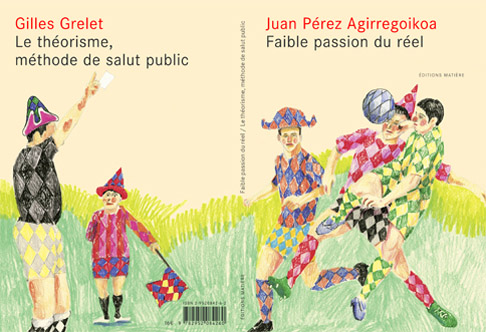Faible passion
du réel
(Weak Passion for the Real)
Juan Pérez Agirregoikoa
Le théorisme,
méthode de salut public
(Theorism, Method of
Public Salvation)
Gilles Grelet
Un se divise en
Deux series
120 pages
double way of reading
full color printing
15 x 21 cm
ISBN: 2-9520842-6-2
June 2006
16 euros
|
WEAK PASSION FOR THE REAL
What is to be done today concerning what remains of the modern project,
of its passion for the real —not the reality on which our modern
times thrive, but the one real passion: devouring, unsustainable,
atrocious— which is nonetheless reasonable? How does one adhere
to an “after” modernity without tumbling into the infamy
of the “post”? What determines this remainder of modernism,
this ultimate modern fidelity offered up as the “weak passion
for the real”?
These are the questions, no less, which guided the hand of Juan Pérez
Agirregoikoa when taking up his felt pens, pencils and tubes of paint.
On the other hand, the author was guiltily obliged to leaf through
certain works, searching a support, or at least a starting point,
in the writings of Alain Badiou and Jacques Lacan. A new departure,
a second breath.
On this occasion, Juan Pérez Agirregoikoa rescued the remains
of Harlequin, modern hero par excellence, figure of modern
painting, the one on whose bare skin geometric abstraction is stitched
one piece at a time. Pérez Agirregoikoa shook him out of his
drabness in order to put him back on the merry‑go‑round.
A not so jolly tour, albeit often funny, but ultimately quite bitter,
hard, hopeless. In any case a trip on a shaky, murderous path, full
of pitfalls, comprising the modern‑day circus and its sinister
parade: democracy, romanticism, surveillance, liberal attitudes, traditions,
clericalism, the cult of the artist, sense and sensibility…
see
an extract
DIRECT THEORY, METHOD OF PUBLIC SALVATION
1.— Direct theory is real: of a radical poverty.
2.— It doesn’t consist in thinking reality, but in destroying
it.
3.— More exactly, to destroy that which, within reality, obstructs
the coming of the Angel, of Enthusiasm, the salvation-invention of
the People.
4.— This obstacle is the semblance, whose matrix is practice.
5.— Descriptive practice (theoricism), destructive practice
(terrorism) or tempered, bustling practice, the pulverulent one from
which everyday life is woven, in all cases affairs of the semblance.
6.— Ranking first among them, since they are entirely surrounded
by it: philosophy.
7.— The people of theory is reality in person, known by way
of the act which establishes it in destroying philosophy, which wants
nothing to do with it.
text
abstract |




